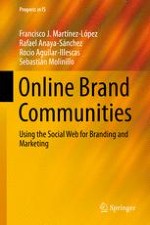2016 | OriginalPaper | Buchkapitel
6. Brand and Social Web
verfasst von : Francisco J. Martínez-López, Rafael Anaya-Sánchez, Rocio Aguilar-Illescas, Sebastián Molinillo
Erschienen in: Online Brand Communities
Aktivieren Sie unsere intelligente Suche, um passende Fachinhalte oder Patente zu finden.
Wählen Sie Textabschnitte aus um mit Künstlicher Intelligenz passenden Patente zu finden. powered by
Markieren Sie Textabschnitte, um KI-gestützt weitere passende Inhalte zu finden. powered by
